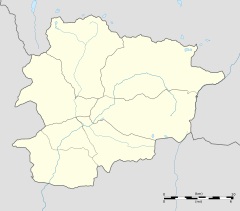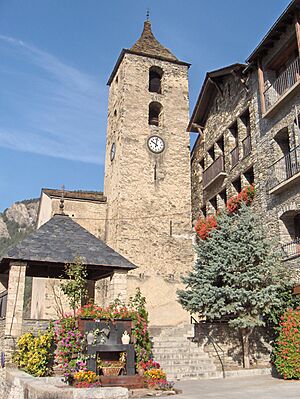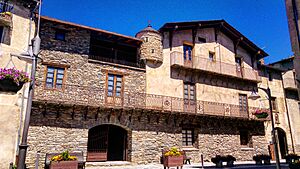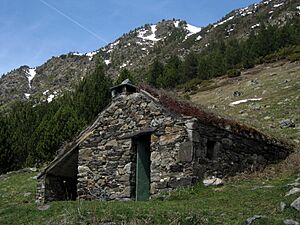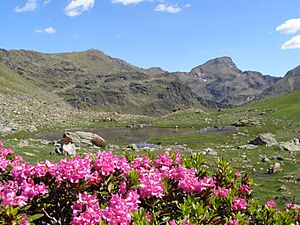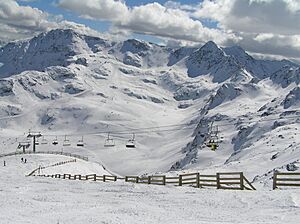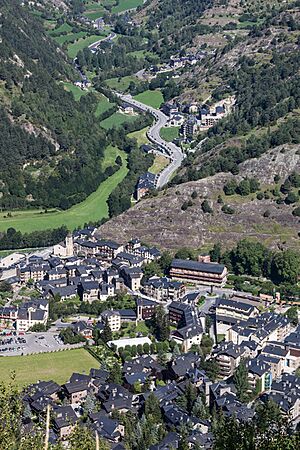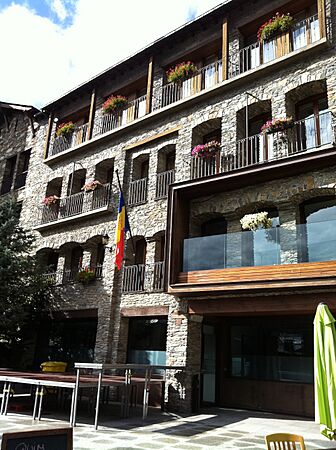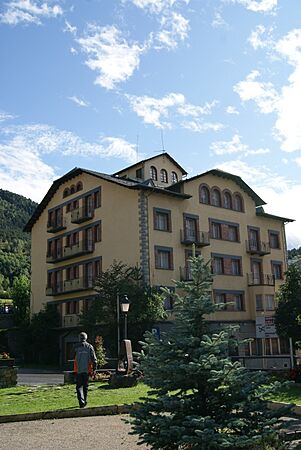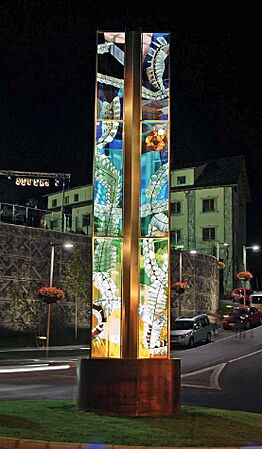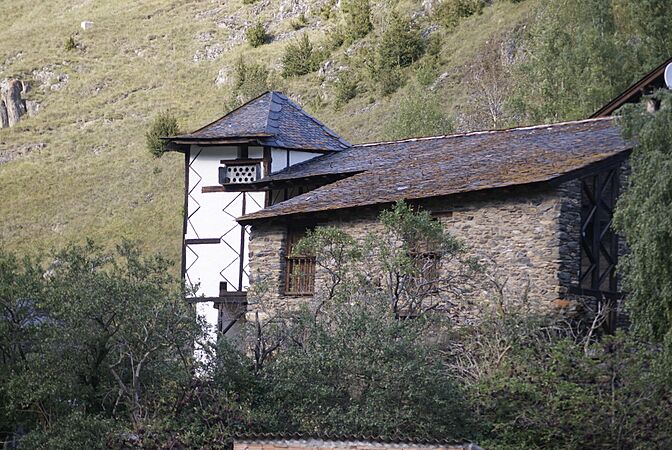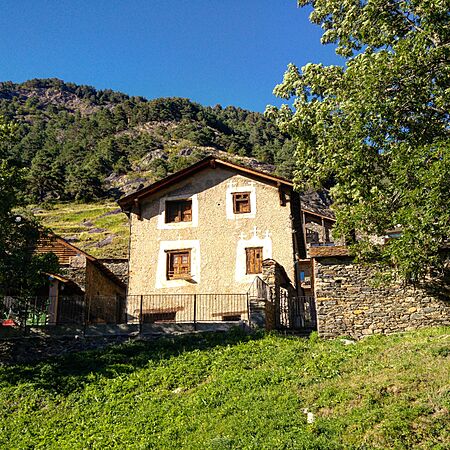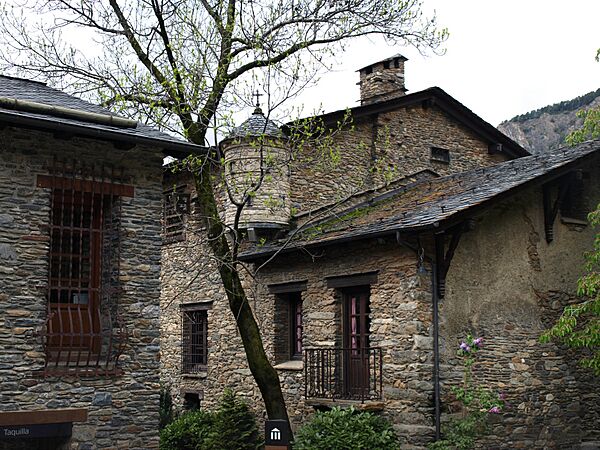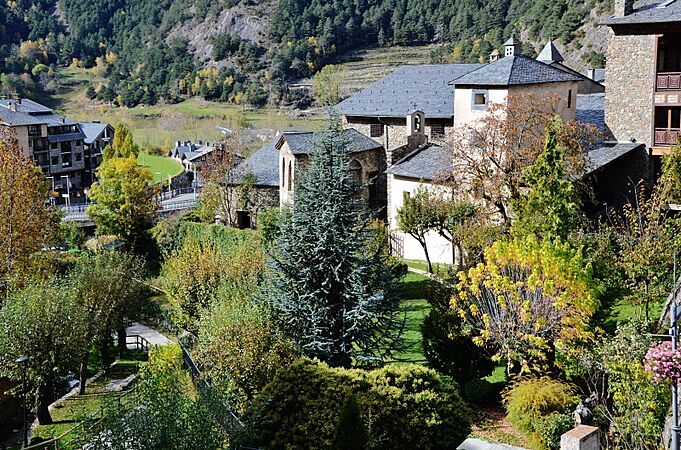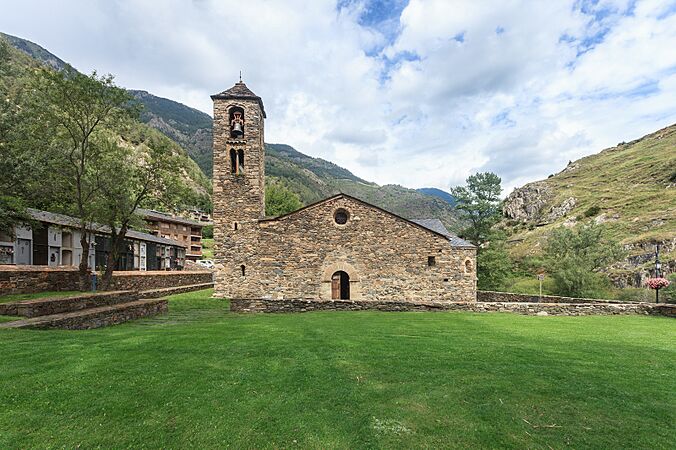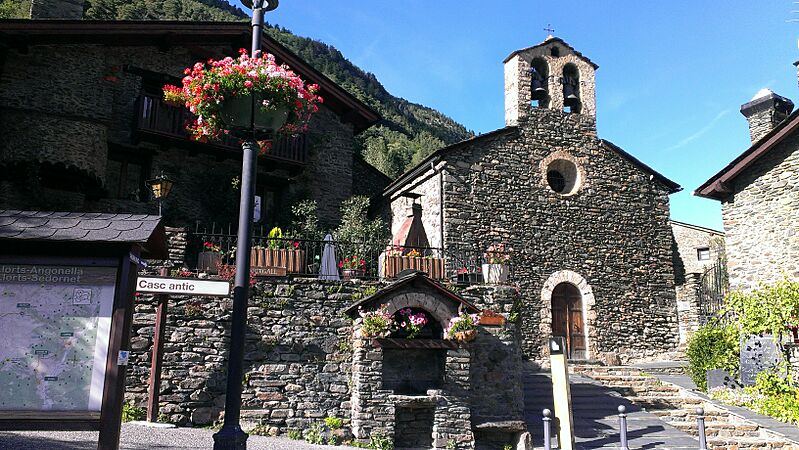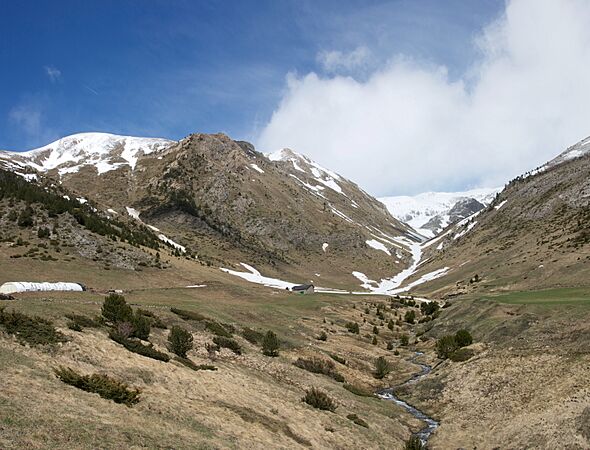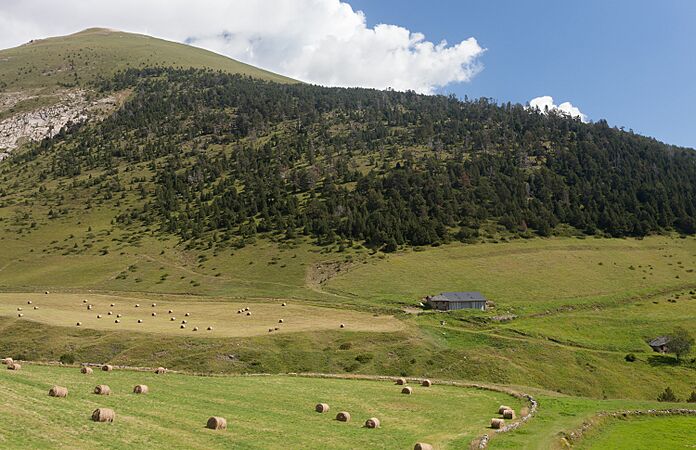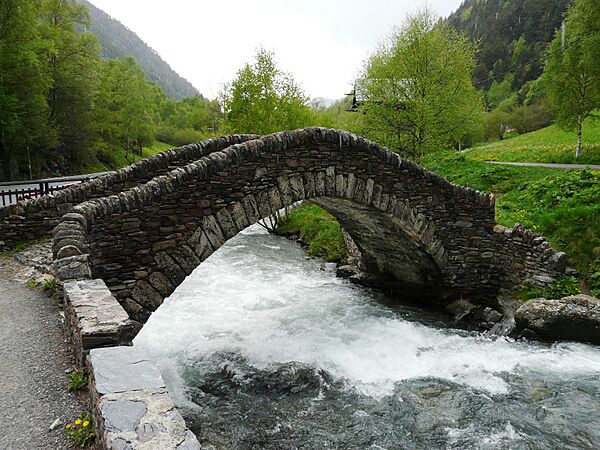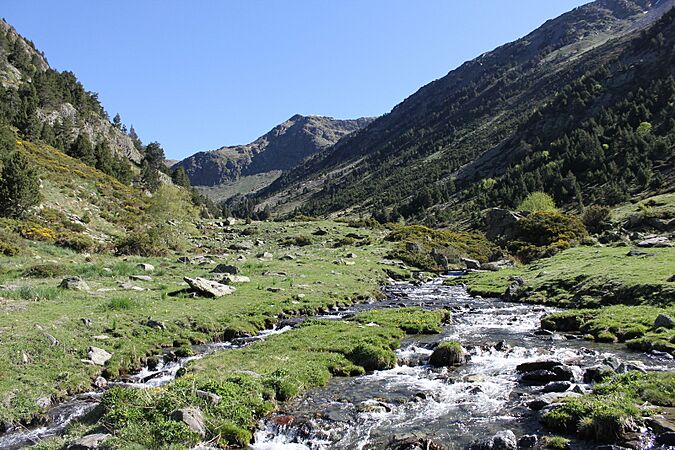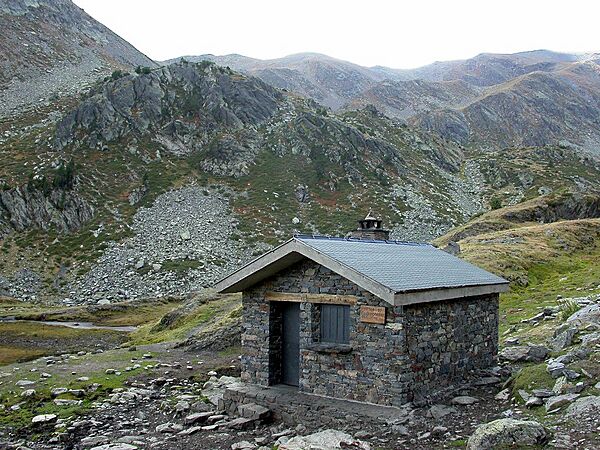Ordino facts for kids
Quick facts for kids
Ordino
|
|||
|---|---|---|---|
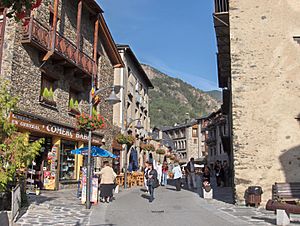
Carrer Major and main street of Ordino town.
|
|||
|
|||
| Country | Andorra | ||
| Parishes | Ordino | ||
| Villages | Ansalonga, Arans, Arcalís, El Serrat, La Cortinada, Les Salines, Llorts, Segudet, Sornàs | ||
| Area | |||
| • Total | 85 km2 (33 sq mi) | ||
| Elevation | 1,300 m (4,300 ft) | ||
| Population
(2017)
|
|||
| • Total | 4,858 | ||
| • Density | 57.15/km2 (148.0/sq mi) | ||
| Demonym(s) | Ordinenc, Ordinenca | ||
| Website | Official site: http://www.ordino.ad/ | ||
Ordino is the northernmost area in the small country of Andorra. It is mostly found in the Valira del Nord river valley. Ordino is also the name of the main town in this area.
Other small villages in Ordino are El Serrat, Ansalonga, Sornàs, La Cortinada, Llorts, Segudet, Arans, Les Salines, and Arcalís. This region is home to the Sorteny National Park, which is the largest nature area in Andorra. About 4,858 people lived here in 2017. The town of Ordino has a beautiful old center with lots of history.
Ordino was named a Biosphere Reserve by UNESCO in 2020. This means it's a special place where nature and people live together in harmony. In 2023, it was also chosen as a Best Tourism Village by UN Tourism.
Contents
Exploring Ordino's Geography
This area shares borders with France and other parts of Andorra like La Massana, Canillo, and Encamp. The main road, called CG-3, is the only way to get in and out all year round. It connects Ordino to the nearby area of La Massana.
Ordino covers 85 square kilometers. This makes it the third largest area in Andorra, after Canillo and Encamp.
Mountains and Views
The town of Ordino sits at the bottom of a mountain called Casamanya. This mountain is 2,740 meters (about 8,990 feet) high. From its top, you can see amazing views because it's almost exactly in the middle of Andorra.
Understanding Ordino's Climate
Ordino has an oceanic climate, which means it has mild temperatures and rain throughout the year. The average temperature each year is about 8.0°C (46.4°F).
The most rain falls in May. July is usually the warmest month, with temperatures around 15.9°C (60.6°F). January is the coldest, with temperatures around 1.5°C (34.7°F). The hottest day ever recorded was 32.9°C (91.2°F) in August 2012. The coldest was -18.9°C (-2.0°F) in February 2005.
A Look at Ordino's History
The name Ordino comes from a very old language spoken before the Romans. It was first written down in the 9th century as Hordinavi.
Ordino is famous for its ironworks from the 1500s. These were places where iron was made, like Farga del Serrat and Farga de l'Areny. Besides being an industrial center, Ordino is also known as the cultural heart of Andorra.
Important Books and Buildings
A very important book called the Manual Digest was written here in 1748 by Antoni Fiter i Rossell. People call it the "Bible of Andorra" because it tells the story, government, and customs of the country.
The parish church of Sant Corneli i Sant Cebrià in Ordino town was mentioned in the year 839. It was mostly built in the 12th and 13th centuries. The Romanesque church of Sant Martí de la Cortinada also has beautiful 12th-century paintings. These churches are great examples of old Andorran art.
Big old houses, like Fiter-Riba or Casa Rossell, belonged to important families. The original Manual Digest book is kept at Casa Rossell. The Areny-Plandolit family house belonged to the owners of the Farga de l'Areny ironworks. These houses show how important families lived between the 1600s and 1800s. In 1972, the government of Andorra bought both houses. They turned them into museums about history and local life.
The Legend of Ordino
Ordino is also known for a local legend called El buner d'Ordino. It's about a bagpiper from Ordino who was going to a festival. On his way, wolves chased him up a tree. He scared them away by playing his bagpipes!
Ordino's Rich Culture
Ordino plays a big part in the culture of Andorra and the Catalan language. It is the main office for the Fundacio Ramon Llull (Ramon Llull Foundation). This group was started in 2008 to share Catalan language and culture around the world.
The National Auditorium of Andorra (Auditori Nacional d'Andorra) is in Ordino town. Since 1983, a classical music event called the International Narciso Yepes Festival has been held there every October. It was started by the famous guitarist, Narciso Yepes.
You can also visit the Postal and Postcard Museum of Andorra (Museu Postal d'Andorra) and the Miniature Museum (Museu de la Miniatura) in Ordino.
La Ruta del Ferro, which means the Iron Route, is a special path. It follows old iron ore mines and country houses along the Valira del Nord river. This route is between Llorts and La Cortinada. It was once the path where people carried iron from the mines to the iron factories.
Exciting Events and Festivities
A special festival in Ordino is El Roser d'Ordino, or The Rose Festival. It used to involve religious parades in July. Now, it's a spring festival celebrating roses, which stand for love and beauty. In the past, young people would pick roses and make bouquets for women. The day included religious events, a parade, and dancing at night.
During the first weekend of August, the streets of Ordino fill with buners. A buner is a type of bagpipe. This instrument is a symbol of Ordino because of the legend about the bagpiper and the wolves. Local people and visitors celebrate by playing bagpipes and having fun.
The songs called Caramelles are also popular. These are religious songs from Old Catalonia sung during Easter. There are also traditional dances that are part of the parish's culture.
Sports and Outdoor Fun in Ordino
The local government of Ordino has a sports center (CEO). It has a swimming pool, gym, squash courts, a sauna, and a rock climbing wall. There's also the CTEO sport center with indoor and outdoor fields. Ordino is also where the Ultra Trail Andorra starts and finishes. This is a very important mountain trail race in Southern Europe.
FC Ordino, a football club started in 2010, is one of the main sports teams here. Their football team plays in the Primera Divisió, which is Andorra's top league.
In the far northwest of Ordino, you'll find the Vallnord (Ordino-Arcalis sector ski station) ski resort. Its highest peaks reach 2,625 meters (about 8,612 feet).
Vallnord is a regular stop for the Freeride World Tour El Dorado since 2015. It's one of the biggest ski events in Andorra. The FIS International Youth Trophy Trofeu Borrufa is also held here every January. The ski resort has hosted major ski mountaineering championships since 2005.
In summer, the ski resort becomes a bike park. Vallnord has hosted mountain biking events for the UCI Mountain Bike World Cup in 2008, 2009, and 2013. The 2015 UCI Mountain Bike & Trials World Championships were also held here.
For road cycling, Arcalis has been a finish line for stages in big races. These include the 1994 Vuelta a España, 2010 Vuelta a España, and the Volta a Catalunya in 2007, 2009, and 2011. Stages of the famous Tour de France also ended at Arcalis in 1997, 2009, and 2016.
The main national road cycling event, La Volta als Ports, finishes in Arcalís. This race is also known as the Tour of the Andorran Passes. It started in the mid-1970s and is now one of the biggest cycling events in Southern Europe.
Protecting Ordino's Environment
Since October 2020, Ordino has been part of the UNESCO's World Network of Biosphere Reserves. This means it's recognized globally for its efforts to protect nature and use resources wisely.
Gallery
-
Noucentist Hotel Casamanya
-
National Auditorium Square by Domènec Fita i Molat
-
Jacint Verdaguer statue
See also
 In Spanish: Ordino para niños
In Spanish: Ordino para niños




